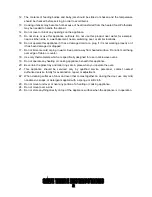
7
overcooking, place delicate areas, such as asparagus tips, toward the center of the turntable.
S
HIELDING
Shield food with narrow strips of aluminum foil to prevent overcooking. Areas that need shielding
include poultry wing tips, the ends of poultry legs, and corners of square baking dishes. Use only
small amounts of aluminum foil. Larger amounts can damage your oven.
T
URNING
Turn foods over midway through cooking to expose all parts to microwave energy. This is especially
important with large foods such as roasts.
S
TANDING
Foods cooked in the microwave build up internal heat and continue to cook for a few minutes after
heating stops. Let foods stand to complete cooking, especially foods such as cakes and whole
vegetables. Roasts need this time to complete cooking in the center without overcooking the outer
areas. All liquids, such as soup or hot chocolate, should be shaken or stirred when cooking is
complete. Let liquids stand a moment before serving. When heating baby food, stir well at removal
and test the temperature before serving.
A
DDING MOISTURE
Microwave energy is attracted to water molecules. Food that is uneven in moisture content should be
covered or allowed to stand so that the heat disperses evenly. Add a small amount of water to dry
food to help it cook.
Power Consumption:
220V~60Hz, 1350W (MICROWAVE)
Output:
900W
Operation Frequency:
2450MHz
Product Dimensions(H×W×D):
366 x 608 x 468 mm
Interior Cavity Dimensions(H×W×D):
240 x 358 x 354 mm
Oven Capacity:
30L
Net Weight:
Approx. 16kg
S
S
P
P
E
E
C
C
I
I
F
F
I
I
C
C
A
A
T
T
I
I
O
O
N
N
S
S

































